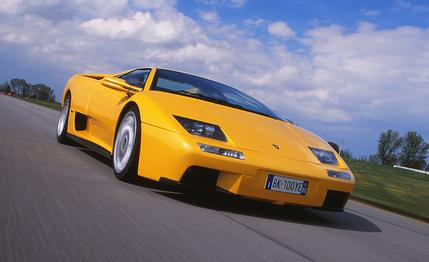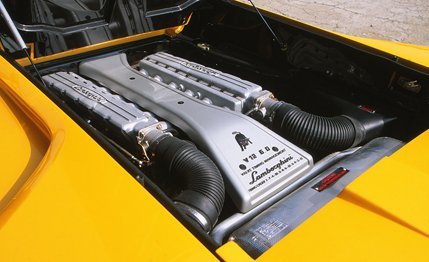
 First Drive Review
First Drive Review




Putting every kind of car imaginable through our tire-squealing, sheetmetal-quivering, eyelid-fluttering performance tests is, as you can imagine, more fun than finding out your fiancee's parents have a large Ferrari collection that needs regular exercise. But every so often, particularly with cars named after, oh, the devil, there emerges at the test track a potential for mechanical hara-kiri that verges on the terrifying.
Such was the case recently when we flew to Milan, Italy, to test the latest Lamborghini Diablo VT (the VT indicates the four-wheel-drive version). This last Diablo in a decade of flamboyant—some daresay outrageous—sports cars first introduced in 1990 is certainly the best Diablo.
The VT is, curiously, a very high-powered four-wheel-drive beast. Situated amidships is the biggest, baddest V-12 engine we've ever tested in a Diablo. For this 2000 model, Lamborghini has lengthened the stroke by 0.16 inch, lightened the crankshaft, used lighter and stronger titanium connecting rods, and updated the old 16-bit engine-control system to a more powerful 32-bit unit. As a result, peak engine output has been promoted to 543 horsepower at 7100 rpm, 20 more than found in the last Diablo. Torque is up 11 pound-feet to 457 at 5800 rpm. Horsepower freaks take note: This latest Diablo now has more horsepower than four four-cylinder Toyota Camrys. (Hey, where else can you get these vital comparisons?)
Despite the fact the rear tires—Z-rated Pirelli P Zeros, good for more than 200 mph--are so wide that, at first glance, they appear to form a solid rolling pin of rubber across the rear of the car (they're 13.2 inches wide), 543 horses and 457 pound-feet of torque can reduce them to pudding. To counter that possibility, the Diablo VT's four-wheel-drive system makes perfect sense. A viscous coupling transfers power to the front wheels if the rears slip; the rest of the time, the Diablo prowls about as a rear-drive car. At most, 28 percent of engine torque is routed to the front wheels. There are no levers to switch or buttons to punch to engage this four-wheel-drive system, and during routine driving, you'd never know this wild Italian was a four-wheeler.
Perform a drag-strip launch, however, and you'll instantly realize the Diablo VT is not a rear-driver. Usually, those of us who drive in hard acceleration tests rely on a touch of wheelspin to get the car moving in the quickest manner. In a four-wheel-drive car with sticky tires, it is almost impossible to get those rears spinning in a hard launch, unless the car has a system that allows some initial rear wheelspin before the fronts get the juice. An example of one such car is the 1997 Porsche 911 Turbo S. Hold the gas pedal down to create 4500 rpm in that sports car, then drop the clutch, and the rear tires will spin for a moment before power is directed to the front wheels; the tires dig in and you're off. In that Porsche, we've recorded 0-to-60-mph blasts in an amazingly fast 3.7 seconds.


But we've tested just one Diablo VT before (C/D, September 1994), because they are very tough to come by—just 23 were sold in the U.S. in 1999, apparently to people who own small countries or athletic shoe companies, at a price of about $275,000. At that test, we declined to risk the dropped-clutch technique, figuring the Diablo's massive tires (235/40ZR-17s up front and 335/35ZR-17s at the rear) and substantial weight (3900 pounds) would result in gobs of traction and no wheelspin. More to the point, there's a good chance that revving the engine and dumping the clutch would fry the clutch and possibly destroy it, and we did not want to find out what that repair bill would look like. A good guess is somewhere in the vicinity of $9000.


Turns out we were half right. The Diablo can, with the right driver, survive drop-clutch launches—we watched three such feats performed remarkably by Lamborghini's own test driver, Mario Fasanetto (You were expecting whom—Jim Scoutten?). After Fasanetto performed three flawless wheelspinning launches in a gray Diablo, a writer for another magazine who was on hand decided he'd like to acquire his own test numbers. Fasanetto got out of the Diablo and instructed the magazine writer to drop the clutch while the engine was revving between 6000 and 7000 rpm. Fasanetto also warned him: "If you make a mistake and don't get wheelspin, you'll destroy the clutch in two tries." The writer drove to the staging area, held the revs at the instructed point, then dumped the clutch. Instead of rear wheelspin, we were treated to the nauseating sound (and then the smell) of an overstressed clutch that was busy producing nightmarish blue smoke. But the Diablo still drove fine, so after performing one more, less stressful launch, the writer parked it.
We were originally scheduled to test that same day, but Ferrari's Formula 1 team decided it needed the track more than we did, so we tested the following day at Pirelli's test track in Vizzola.
On our way there in a fresh yellow Diablo, we chatted with Fasanetto and marveled at the Diablo's interior comfort. Diablos are not yet ready to be considered luxury vehicles, but they are unexpectedly pleasant automobiles. According to Lamborghini's new chairman, Giuseppe Greco, Diablo owners drive their cars an average of 6500 miles a year, three times farther than they drove them 10 years ago. That suggests that customers are happy with the continual improvements Lamborghini has made beneath that flamboyant body.